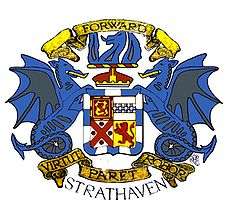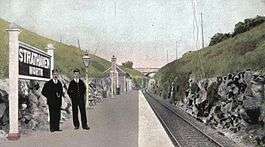Strathaven
| Strathaven | |
| Scottish Gaelic: Strath Aibhne | |
| Scots: Straiven | |
 |
|
 Strathaven |
|
| Population | 7,484 [1] (2011 Census) est. 7,500 (2013) |
|---|---|
| Civil parish | Avondale |
| Council area | South Lanarkshire |
| Lieutenancy area | Lanarkshire |
| Country | Scotland |
| Sovereign state | United Kingdom |
| Post town | STRATHAVEN |
| Postcode district | ML10 |
| Dialling code | 01357 |
| Police | Scottish |
| Fire | Scottish |
| Ambulance | Scottish |
| EU Parliament | Scotland |
| UK Parliament | East Kilbride, Strathaven and Lesmahagow |
| Scottish Parliament | Clydesdale |
Coordinates: 55°40′37″N 4°03′54″W / 55.677°N 4.065°W
Strathaven ![]() i/ˈstreɪvən/ (Scots: Straiven,[2] from Gaelic: Strath Aibhne [strah ˈajnə], meaning "valley of the Avon") is a historic market town in South Lanarkshire, Scotland and is the largest settlement in Avondale. The town was granted a Royal Charter in 1450, making the Town of Strathaven a burgh of barony. The town's main industry was weaving in the 19th and early 20th centuries, however this declined when faced by competition from Glasgow. The industrial revolution bypassed the town as it had little to offer in the way of natural resources, and thus has grown into more a commuter settlement, however it is still the main service centre for the surrounding area of Avondale. The current estimated population is 7,500.
i/ˈstreɪvən/ (Scots: Straiven,[2] from Gaelic: Strath Aibhne [strah ˈajnə], meaning "valley of the Avon") is a historic market town in South Lanarkshire, Scotland and is the largest settlement in Avondale. The town was granted a Royal Charter in 1450, making the Town of Strathaven a burgh of barony. The town's main industry was weaving in the 19th and early 20th centuries, however this declined when faced by competition from Glasgow. The industrial revolution bypassed the town as it had little to offer in the way of natural resources, and thus has grown into more a commuter settlement, however it is still the main service centre for the surrounding area of Avondale. The current estimated population is 7,500.
Location
The town is located on the edge of the valley of the Avon Water, around 6 miles from Hamilton, and 18.2 miles from Glasgow. The A71, which connects Edinburgh and Kilmarnock passes through the town. In the 2001 census the town had a population of 7,700. Strathaven has one secondary school and three primary schools - Kirklandpark Primary, Wester Overton Primary, and St Patrick's Primary. It also has a grass airfield about two miles to the north west, on Lethame Road.
History
Strathaven has a long history as a market town. A Roman road passes close by, on the south side of the Avon Water, which led to the Roman fort at Loudoun Hill near Darvel. The origins of Strathaven Castle are obscure, but it is believed to have been built around 1350 by the Bairds, on a bend of the Powmillon Burn. Today it is a ruin, with a single tower and sections of wall remaining beside the A71.
The Barony of Strathaven was acquired in 1362 by Archibald the Grim, Lord of Galloway, by his marriage to Joanna, daughter to Maurice de Moravia, 1st Earl of Strathearn, great Moray heiress. The settlement within the lands of Strathaven became a Burgh of barony in 1450. It still retains its traditional character despite the growth of more modern housing. The centre of the town is occupied by the market square, formerly a grassed common, and still known as Common Green, or just 'The Green'. Linking the town and the castle is the old 'Boo Backit Brig' ('bow-backed bridge'), a small arched bridge. The Old Parish Church, with its landmark spire, was built in 1772, and was the place of worship of the Duke of Hamilton who maintained a shooting lodge at nearby Dungavel House.
The town prospered in the 18th and 19th centuries as a weaving town, although there were many merchants living here too. The town played a significant part in the Radical War of 1820, when James Wilson led a band of radicals on a march to Glasgow, to join a rumoured general uprising, which never actually happened. Wilson was hanged for treason, and in 1846 a memorial was built in his honour in the town cemetery. The history of Strathaven is now documented in the town's John Hastie Museum.
Its most famous 'modern' resident was Sir Harry Lauder (1870–1950) whose mansion, Lauder Ha', or Hall, was just above the town on the road to Kilmarnock. Sir Harry spent the Second World War years there, and died in February 1950. The family retained the property until Death Duties of 65% forced a sale in the late 1960s. It remains a private residence.
Dungavel House on the outskirts of Strathaven was the location where German Deputy Führer Rudolf Hess originally intended to land on the evening of 10 May 1941 in a misguided attempt to seek peace talks with the Duke of Hamilton. However bad weather and poor navigation resulted in Hess having to land at Floors Farm in Eaglesham.
Town centre
Despite competition from the nearby large towns of East Kilbride and Hamilton, Strathaven still has a number of craft and gift shops, alongside well known town centre names. There are two banks, Halifax Bank of Scotland and Royal Bank of Scotland office in the Common Green. There are a number of businesses providing extra attraction to the town. Brian Young's Garden Centre and Lawn Mower centre on Newton Road, The new Auction mart half a mile from Strathaven on the Hamilton Road. This includes a number of smaller businesses reflecting Strathaven's equestrian following (horses) and a small cafe. The town has long been Sunday Run territory with several town centre eating establishments as well as four public houses. The fifth pub until recently, The Castle Tavern, is no longer open due to a collapse during renovations in early 2011.
Strathaven Academy
Strathaven Academy is the town's only secondary school and in 2012 was voted the 33rd best school in Scotland and top in South Lanarkshire. Following a major refurbishment the new building was completed in 2009 on the original site.
Strathaven railway stations

Strathaven had, at various times, three railway stations.
- Strathaven (Old), the first station, was the terminus of the Hamilton and Strathaven Railway. The railway was taken over by the Caledonian Railway; and the station was replaced by Strathaven North.
- Strathaven North, a terminal station on the Hamilton and Strathaven Branch of the Caledonian Railway, opened in October 1904, closed temporarily during World War I; and closed on 30 September 1945.
- Strathaven Central, on the Darvel and Strathaven Railway closed in June 1964 to services from the east, although the line to Darvel closed in 1939.
Strathaven Airfield
Strathaven Airfield is home to a microlight flying school, which operates both the traditional-style weightshift microlights and the light aircraft-style ones, and the new airfield manager's house was featured on Channel 4's Grand Designs in October 2013.[3] There are approximately 35 aircraft - both light aircraft and microlights - hangared at Strathaven in two modern purpose-built hangars. The airfield is also home to an annual local music festival, HangarFest. The airfield was set up on the old Couplaw Farm, which The Scottish Flying Club Ltd bought in May 1964. The club had begun flying in 1927 at the old Renfrew Airport [4] but was left homeless after Renfrew was nationalised in 1946. Strathaven Airfield was given to the RAF Benevolent Fund in 1974 and then sold privately in 2005. It has three grass runways, the main runway is oriented 09/27 and is 530m long (with a 100m starter extension on 27 available on request). The airfield co-ordinates in the UK Air Pilot ENR 5.5-17 are: 554049N 0040654W [5]
Religion
Strathaven contains six churches[6] including three Church of Scotland parishes: Avendale Old (built in 1772) linked with Drumclog Parish Church,[7] Strathaven Rankin linked with Chapelton Parish Church,[8] and East Parish Church (built in 1777) linked with Glassford Parish Church.[9]
The only Catholic Church in the town is St. Patricks Catholic Church (built in 1863).[10]
There is an active ecumenical body, consisting of six churches in the area (5 within the town, one nearby), named "Hope Strathaven", which work together bringing a mix of community projects that reflect faith and service.[11]
Sport
Strathaven is home to several sports clubs, which include:
- Strathaven Army Cadet Force
- Strathaven Dynamo AFC
- Strathaven Rugby Club
- Strathaven Striders
- Strathaven Golf Club
- Strathaven Bowling Club
- Avondale Bowling Club
- Strathaven Tennis Club
- Strathaven Badminton Club
- Avon Angling Club
- Upper Avon Angling Association
Strathaven's Sport Centre underwent refurbishment in 2009 as a result of the demolition and reconstruction of Strathaven Academy.
Sports facilities in Strathaven include an indoor swimming pool and gym, three grass football pitches, two ash football pitches, four tennis courts, two rugby pitches and several badminton courts in church and primary school halls.
Famous residents (past and present)
- Bertie Auld Footballer and one of the Lisbon Lions who played with Celtic
- Stuart Braithwaite Singer and musician with the band Mogwai
- William Craig Brownlee Clergyman, author and Professor of Languages at Rutgers University
- Eric Caldow Scottish international footballer who played with Rangers
- William Craig Surgeon and botanist, President of the Edinburgh Botanical Society and Fellow of the Royal Society of Edinburgh
- David Fernández Spanish footballer who spent most of his career in Scotland playing at clubs including Celtic and Kilmarnock
- James Mackinnon Fowler Australian politician and founding member of the Victorian Socialist League
- Gordon Gibb Businessman, CEO of Flamingo Land Ltd and former chairman of Bradford City Football Club.
- Sir Robert Giffen Financial editor of The Times newspaper and President of the Royal Statistical Society
- Andy Kerr Labour Politician and former Scottish Executive Health Minister
- Sir Harry Lauder Singer, comedian and music hall entertainer
- Thomas Leiper Tobacco merchant
- Barry Leitch Composer
- Stuart McCall Scottish international footballer who played for Rangers, Everton and Bradford City
- Una McLean Actress and comedian
- Aileen Neilson Paralympian
- Linda Fabiani (Scottish politician) SNP politician and former Scottish Executive Minister for Europe, External Affairs and Culture
- Paulo Quadros (Justice and Social Health campaigner) Leader of the team who made Strathaven Scotland's First Fairtrade Town
- Linda Ormiston Opera singer and actress
- Corrie Scott Swimmer and bronze medalist at the 2014 Commonwealth Games
- Stevie Starr Performance artist and contestant on Britain's Got Talent and America's Got Talent
- Andy Stewart, Conservative MP from 1983-92 for Sherwood, and Chairman from 1992-8 of the Agricultural Training Board
- Ricky Warwick Singer and guitarist with rock bands The Almighty and Circus Diablo currently new vocalist with Thin Lizzy
- James Wilson Revolutionary leader who participated in the Scottish Insurrection of 1820
- The Almighty (band)
- Adam Stevenson Local Ned
References
- ↑ "Comparative Population Profile: Strathaven Locality". Scotland's Census Results Online. 2001-03-27. Retrieved 2012-07-02.
- ↑ The Online Scots Dictionary
- ↑ http://www.channel4.com/programmes/grand-designs/episode-guide
- ↑ Renfrew Airport
- ↑ http://www.ead.eurocontrol.int/eadbasic/pamslight-82F56B368122B97304674DE503ECA454/7FE5QZZF3FXUS/EN/AIP/ENR/EG_ENR_5_5_en_2014-05-29.pdf
- ↑ http://www.churches-uk-ireland.org/towns/s/strathaven.html
- ↑ http://www.avendale-drumclog.com
- ↑ http://rankinandchapelton.wikidot.com/
- ↑ http://www.scotlandschurchestrust.org.uk/church/east-parish-church-strathaven
- ↑ http://www.rcdom.org.uk/parishes_stpatricks_strathaven.htm
- ↑ http://hopestrathaven.co.uk/the-strathaven-churches.php
External links
- Strathaven castle Website
- Town of Strathaven
- Strathaven in Old Postcards
- Scottish Gazetteer : Strathaven